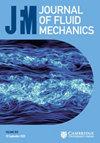论湍流分离气泡的低频动力学
IF 3.9
2区 工程技术
Q1 MECHANICS
引用次数: 0
摘要
研究了不可压缩的、由压力梯度诱导的湍流分离气泡(TSB)的低频模态和非模态线性动力学,目的是研究实验研究中通常观察到的低频收缩和膨胀(呼吸)的机理。所关注的构型是在平坦的测试表面上通过连续的不利和有利压力梯度产生的 TSB。分析所选的基流是来自 Coleman 等人直接数值模拟的平均 TSB(《流体力学》,第 847 卷,2018 年,第 28-70 页)。全局模式分析显示,线性算子的特征模式在所有频率和波数下都是阻尼的。此外,当与分离长度成比例时,阻尼最小的特征模出现在零频率和低非零跨度波数处。然后采用残余溶剂分析来研究流动的受迫动态。在低频处,也可以看到一个低、非零跨度波长的区域,在该区域,受体似乎是由已识别的弱阻尼全局模式驱动的。相应的最佳能量增益具有一阶低通滤波器的形状,其截止频率与 TSB 的低频不稳定性一致。将解析分析的结果与 Le Floc'h 等人(《流体力学》,第 902 卷,2020 年,A13 期)在类似 TSB 流体中的非稳态实验数据库进行了比较。实验结果表明,最优响应与实验计算出的第一频谱正交分解模式之间的一致性接近于 95,\%$,而最优响应的跨度波数与实验捕捉到的低频呼吸运动的波数一致。这表明实验观察到的低频波动与解析分析计算出的响应非常吻合。基于这些结果,我们提出,在弱阻尼全局模式的驱动下,流动的强迫动力学是 TSB 实验研究中常见的低频呼吸运动的一个可信的起源机制。本文章由计算机程序翻译,如有差异,请以英文原文为准。
On the low-frequency dynamics of turbulent separation bubbles
The low-frequency modal and non-modal linear dynamics of an incompressible, pressure-gradient-induced turbulent separation bubble (TSB) are investigated, with the objective of studying the mechanism responsible for the low-frequency contraction and expansion (breathing) commonly observed in experimental studies. The configuration of interest is a TSB generated on a flat test surface by a succession of adverse and favourable pressure gradients. The base flow selected for the analysis is the average TSB from the direct numerical simulation of Coleman et al. (J. Fluid Mech. , vol. 847, 2018, pp. 28–70). Global mode analysis reveals that the eigenmodes of the linear operator are damped for all frequencies and wavenumbers. Furthermore, the least damped eigenmode appears to occur at zero frequency and low, non-zero spanwise wavenumber when scaled with the separation length. Resolvent analysis is then employed to examine the forced dynamics of the flow. At low frequency, a region of low, non-zero spanwise wavenumber is also discernible, where the receptivity appears to be driven by the identified weakly damped global mode. The corresponding optimal energy gain is shown to have the shape of a first-order, low-pass filter with a cut-off frequency consistent with the low-frequency unsteadiness in TSBs. The results from resolvent analysis are compared to the unsteady experimental database of Le Floc'h et al. (J. Fluid Mech. , vol. 902, 2020, A13) in a similar TSB flow. The alignment between the optimal response and the first spectral proper orthogonal decomposition mode computed from the experiments is shown to be close to $95\,\%$ , while the spanwise wavenumber of the optimal response is consistent with that of the low-frequency breathing motion captured experimentally. This indicates that the fluctuations observed experimentally at low frequency closely match the response computed from resolvent analysis. Based on these results, we propose that the forced dynamics of the flow, driven by the weakly damped global mode, serve as a plausible mechanism for the origin of the low-frequency breathing motion commonly observed in experimental studies of TSBs.
求助全文
通过发布文献求助,成功后即可免费获取论文全文。
去求助
来源期刊
CiteScore
6.50
自引率
27.00%
发文量
945
审稿时长
5.1 months
期刊介绍:
Journal of Fluid Mechanics is the leading international journal in the field and is essential reading for all those concerned with developments in fluid mechanics. It publishes authoritative articles covering theoretical, computational and experimental investigations of all aspects of the mechanics of fluids. Each issue contains papers on both the fundamental aspects of fluid mechanics, and their applications to other fields such as aeronautics, astrophysics, biology, chemical and mechanical engineering, hydraulics, meteorology, oceanography, geology, acoustics and combustion.

 求助内容:
求助内容: 应助结果提醒方式:
应助结果提醒方式:


